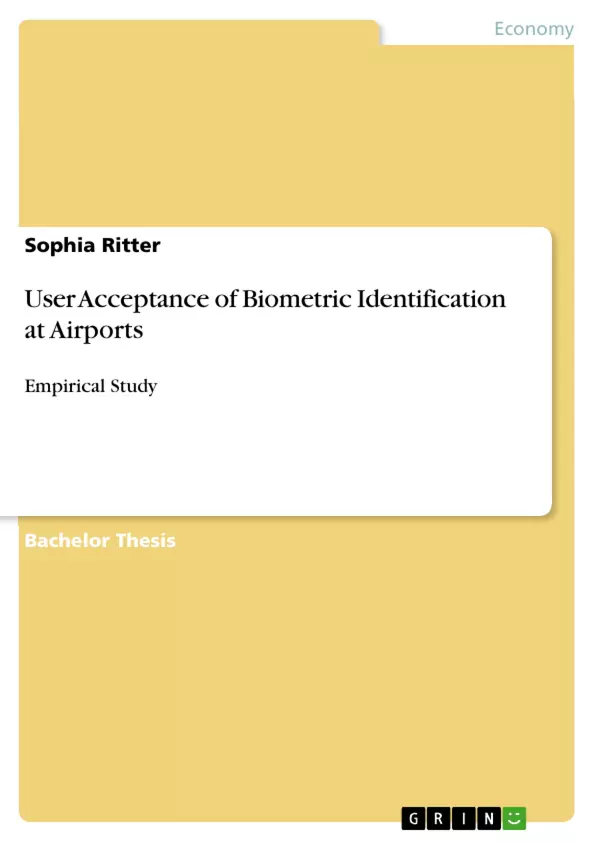In this bachelor thesis, the focus is on investigating the factors that impact user acceptance of biometric identification at airports and assessing the extent of their influence. Drawing from existing literature, several factors such as the number of flights taken annually, gender, interest in new technologies, importance placed on data privacy, and fear of infection during the COVID-19 pandemic are identified and transformed into testable hypotheses. Through a quantitative survey, a total of 307 individuals are interviewed to empirically examine these factors.
Inhaltsverzeichnis (Table of Contents)
- 1 Introduction
- 1.1 Problem Statement
- 1.2 Thesis Structure
- 2 Basics of Biometric Identification
- 2.1 Definitions and Requirements
- 2.2 Historical Development
- 2.3 Types of Biometrics
- 2.4 Biometric Identification Process
- 2.5 Data Privacy Issues
- 3 Biometric Identification at Airports
- 3.1 Airport Touchpoints
- 3.2 Biometric Implementation Programs
- 3.2.1 Biometric Path: Emirates
- 3.2.2 Biometric Boarding: Lufthansa Group & Star Alliance
- 3.2.3 Biometric Terminal: Delta Airlines
- 3.2.4 One ID: IATA
- 4 User Acceptance of Technology
- 4.1 Relevance and Measuring Instruments
- 4.2 Unified Theory of Acceptance and Use of Technology
- 4.3 User Acceptance of Biometric Technology at Airports
- 5 Empirical Research
- 5.1 Research Approach
- 5.2 Survey Structure and Question Types
- 5.3 Statistical Approach
- 5.4 Presentation of the Results
- 5.4.1 Demographic Information
- 5.4.2 H1: Number of Flights Per Year
- 5.4.3 H2: Gender
- 5.4.4 H3: Interest in New Technological Devices
- 5.4.5 H4: Importance of Data Privacy
- 5.4.6 H5: COVID-19
- 5.4.7 Open Questions
- 5.5 Discussion of the Results
- 5.6 Limitations and Further Research
- 6 Conclusion
Zielsetzung und Themenschwerpunkte (Objectives and Key Themes)
This thesis explores the user acceptance of biometric identification at airports. The study aims to identify the relevant factors influencing user acceptance and assess their impact. The research seeks to contribute to the understanding of user behavior and decision-making processes concerning biometric technologies in the aviation sector.- Factors influencing user acceptance of biometric identification at airports
- Impact of various factors on user acceptance
- Application of the Unified Theory of Acceptance and Use of Technology (UTAUT) to analyze user acceptance
- Data privacy concerns related to biometric identification
- The role of COVID-19 in shaping user perceptions of biometric technologies
Zusammenfassung der Kapitel (Chapter Summaries)
- Chapter 1: Introduction This chapter introduces the research topic, outlining the problem statement and the structure of the thesis. It establishes the context for the study and highlights the importance of user acceptance in the implementation of biometric identification at airports.
- Chapter 2: Basics of Biometric Identification This chapter provides a comprehensive overview of biometric identification, including its definitions, historical development, types, process, and associated data privacy issues. It establishes a foundational understanding of the technology and its implications for the aviation industry.
- Chapter 3: Biometric Identification at Airports This chapter examines the application of biometric identification at airports, highlighting key touchpoints and implementation programs. It explores different initiatives by major airlines and the International Air Transport Association (IATA) to streamline passenger processes through biometric technologies.
- Chapter 4: User Acceptance of Technology This chapter delves into the theoretical framework of user acceptance, focusing on the Unified Theory of Acceptance and Use of Technology (UTAUT). It discusses the relevance of UTAUT in understanding user acceptance of technology, particularly in the context of biometric identification at airports.
- Chapter 5: Empirical Research This chapter presents the empirical research conducted for the thesis. It outlines the research approach, survey structure, statistical approach, and the presentation of results. The findings are analyzed to assess the impact of various factors on user acceptance of biometric identification at airports.
Schlüsselwörter (Keywords)
This research focuses on user acceptance of biometric identification at airports, exploring factors that influence user decisions and the impact of these factors. Key concepts include biometric technologies, airport touchpoints, data privacy, user acceptance, and the Unified Theory of Acceptance and Use of Technology (UTAUT). The study also examines the role of COVID-19 in shaping user perceptions of biometric technologies.
Ende der Leseprobe aus 76 Seiten
- nach oben
- Arbeit zitieren
- Sophia Ritter (Autor:in), 2021, User Acceptance of Biometric Identification at Airports, München, GRIN Verlag, https://www.grin.com/document/1372232
Blick ins Buch



